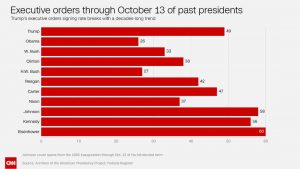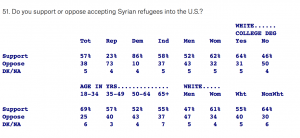Is the United States on its way to tyranny?
Chapter 12 in The Struggle for Democracy outlines all of the elements of presidency in the United States. The chapter explains how the framers developed the conception of the presidency and it exists today in a much different way than initially intended. Before the 20th century, the nation did not often require a very strong presidency, especially in the areas of foreign policy and military leadership. In the 20th century, the US developed into a world power, involved in military, diplomatic, and economic activities around the globe. With that structural development came a simultaneous increase in the power and responsibility of the president. Additionally, the transformation of the economy increased the demands for more government supervision. As this role of government grew, so did the president’s role as chief executive. Overtime, presidential actions became the precedent for their successors, changing expectations by the public and political elites and enhancing presidential responsibilities and powers.
As we know, the president wears many hats – chief of state, legislative leader, manager of the economy, chief executive, foreign policy and military leader, and party leader. To assist the president in his daily responsibilities and tasks, he has a huge support system called the institutional presidency, which is the permanent bureaucracy associated with the presidency, designed to help the incumbent of the office carry out his responsibilities. There is also the White House Staff, the Executive Office of the President, the Vice President, the Cabinet, and the Congress. The Congress and the President are often at odds, which is a structural fact of American politics, deliberately intended by the framers of the Constitution. In the US, separated powers and mutual checks are real and consequential for what government does, even though presidents have seriously expanded their powers by increasing their use of executive orders. Ultimately, our constitutional structure ensures that what the president can do is limited and influenced by Congress, but executive orders still allow presidents to make decisions without the approval or participation of Congress.
The president is the chief executive over certain matters, such as the military and foreign policy, but not others. Does the president have too much power or not enough power? By conducting thorough research online, there are arguments on either side of why the president should or should not have that executive power and be able to bypass Congress in order to issue executive orders.
Despite criticizing Obama’s use of executive orders throughout his campaign, as of October 13, 2017, Trump signed 49 executive orders since coming into office (CNN Article). At the time, he was on pace to sign more executive orders than any president in the last 50 years.
Those who oppose executive orders likely do not support the president or align with the president’s party because they would not want them to have the ability to make decisions that surpass other decision-making parties and American citizens. For example, Trump’s travel ban executive order exposes the defective aspect of executive orders as it seems as though Trump abused his power, attempting to institute extremist policies without communicating with other parties or the American public. A Quinnipiac poll shows that the majority of the public supported accepting Syrian refugees into the US, with the majority being Democratic supporters (unsurprisingly).
Despite these numbers, Trump called for immediate suspension of immigration from countries with ties to terror (Syria, Yemen, Sudan, Somalia, Iraq, Iran and Libya) for a time period of 90 days and suspended Syrian refugees indefinitely. The ABC News article outlines the executive order, explaining that it “calls for prioritizing refugee entry on the basis of ‘religious-based persecution…’” Trump’s attack on religious beliefs goes against our First Amendment rights of freedom to practice religion. There was a global reaction of disapproval and loss of hope as a country as more than 2,000 religious leaders from across the country signed a letter to President Trump opposing policy changes that would bar refugees based on religion or nationality. Trump’s immigration ban brings into question our popular sovereignty – specifically, how the majority of the American public was not represented in government and policies enacted.
Executive orders further become a problem by the ways in which the Constitution distorts democratic choice: “Because of factors like vote suppression, gerrymandering, nearly unlimited campaign spending, and institutions that over-represent white rural voters such as the Senate and the Electoral College, Republicans have been able to lose the popular vote and still win elections,” (Reuters Article). This exacerbates the problem because Republican candidates win despite not winning the majority of votes and Republican Congresses are incapable of fulfilling their “incoherent campaign promises.” As a result, the Republican president is elected by a minority and enacts the right-wing’s demands through executive orders. How does this system represent our American and democratic ideals? When evaluating our democracy, we must evaluate whether executive orders represent the desires and beliefs of the American public, and if they do not, our democracy is flawed.
In a Faithful Politics article, a religious author explains that regardless of how good executive orders sound or how much they will benefit us, they are an explicit illegal usurpation of power: “This is one of many steps in the deconstruction of our Constitution, and the loss of freedoms and liberty, and the eventual rise of a tyrant…Many presidents abuse their power through legislative executive orders, belittling Congress in the process and stealing our Constitutional rights and freedoms…Let us not become ignorant or passive when it comes to holding our government accountable.”
Ultimately, executive orders can quickly lead to an abuse of power and deny American citizens their popular sovereignty. Fortunately, checks and balances enable Congress to overturn an executive order, but, there will always be at least short-term repercussions of an executive order, such as the offensive and disrespectful message Trump expressed to the world about our nation’s stance on the war in Syria and our “assumptions” about countries involved in terrorism. To improve future situations, perhaps there should be more clear guidelines in the Constitution of when a president can issue executive orders. Do you think executive orders are necessary to our democracy?

